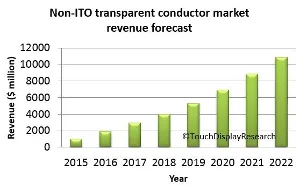The arguments for replacing indium tin oxide (ITO) with non-ITO transparent conductors are powerful and widely known.

Although ITO is quite transparent, it is not a very good conductor. Even more important, as flexible displays emerge as a significant category, ITO is brittle and cracks when flexed. Although the supply of indium has been stable recently, the metal is obtained as a by-product of large-scale mining operations for more mainstream materials, so its supply is dependent on economic forces not in the control of display and touch-screen makers. Some years ago, the price of indium spiked. Although the spike did not last long, the trauma has not been forgotten.
So, it shouldn’t be a surprise that substantial effort and investment have been devoted to developing replacements for ITO that are transparent, flexible, and more conductive. These efforts have been fruitful.
Although a variety of exotic materials are still under development, the solutions that have reached the market use metal meshes or nanowires, usually silver. The metal-mesh approach won early acceptance, but reportedly fell from favor because of geometries that were too large for high-resolution displays and problems with meeting supply commitments.
Silver nanowire (AgNW) benefitted from its competitor’s mis-steps, and is now the dominant ITO-replacement technology. Although TouchDisplay Research predicts the non-ITO transparent conductor market to increase from less than $1billion this year to nearly $11 billion in 2022, ITO currently retains the vast majority of the transparent conductor market.

The best-know AgNW solution to date is probably that of Cambrios. Cambrios sells an ink containing fine AgNWs, which can be patterned after application, and the company has been enjoying an expanding business.
A less well-known company is C3nano, which has been in stealth mode for the last four or five years, according to CEO Cliff Morris. The company was spun out of Zhenan Bao’s chemical engineering lab at Stanford in 2010 has raised $20 million in funding. C3nano has exploded out of stealth mode this year.
In March, it announced a partnership with Kimoto, a leading manufacturer of R2R hard-coated films for the display and touch-screen industries. In April it aquired Aiden Co., which C3nanon describes as “Asia’s largest silver nanowire manufacturer”.
Early this month (May 2015), the company announced an agreement with Nissha Printing to jointly develop the next generation of AgNW inks.
And at SID Display Week, next week, the company will introduce its ActiveGard hardcoat, which is intended to bend with flexible displays and transparent conductors without cracking, and will also have another announcement that Morris would not share with me when I interviewed him by telephone in early May. (I think its another acquisition – Man. Ed.)
So, on what technical development is all of this activity based? Like other AgNW approaches, C3nano’s deposits an ink containing silver nanowires that overlap each other in a loose web. The wire web is mostly open so light can pass through, but the web is dense enough to provide good conductivity. C3nano’s contribution is what it calls Nanoglue technology, a catalyst-mediated process that causes the AgNWs to fuse where they cross. This results in greater conductivity for a given wire diameter, which can be used to deliver lower sheet resistance, less haze, or a combination of the two, says Morris.
ITO-replacement technologies will be one of the featured topics at Display Week. I look forward to learning more. – Ken Werner

